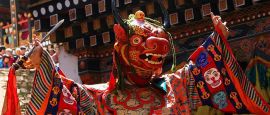Bhutan History, Language and Culture
History of Bhutan
Bhutan's history is a fascinating tale of mystics, monarchs, and mountains—a kingdom that has fiercely guarded its sovereignty while embracing change on its own terms. Unlike many of its neighbours, Bhutan was never colonised, allowing it to develop a unique cultural and political identity, shaped largely by Tibetan Buddhism.
Legends trace Bhutan's origins to the 8th century, when Guru Rinpoche (Padmasambhava), a revered Buddhist saint, arrived from Tibet, subduing local deities and introducing Tantric Buddhism, which remains central to Bhutanese life. Over the centuries, various Buddhist masters and feudal lords ruled different regions, but it wasn't until the 17th century that Bhutan was unified under Zhabdrung Ngawang Namgyal, a Tibetan lama who established the dual system of governance, blending both religious and secular rule. He built Bhutan's iconic dzongs (fortress-monasteries), many of which still stand today.
After Zhabdrung's death, Bhutan experienced internal conflicts and power struggles, yet managed to maintain its independence. In 1907, the country transitioned to monarchy, with the coronation of King Ugyen Wangchuck, the first Druk Gyalpo (Dragon King). The Wangchuck dynasty has ruled ever since, overseeing Bhutan's steady modernisation while preserving its deep-rooted traditions.
In 2008, Bhutan made a historic shift to a constitutional monarchy, holding its first parliamentary elections. Yet, despite embracing democracy, Bhutan remains deeply connected to its unique philosophy of Gross National Happiness (GNH)—prioritising well-being over economic growth, a rare and refreshing approach in today's world.
Did you know?
• Bhutan is the only carbon-negative country in the world, thanks to its forests covering over 70% of the country. The government enforces strict conservation policies, ensuring at least 60% of its land remains untouched.
• There are no traffic lights in Bhutan—even in the capital, Thimphu. A traffic light was once installed but quickly removed after locals found it too impersonal.
• Television and the internet were banned until 1999 to preserve Bhutan's culture. The country still carefully regulates its exposure to globalisation.
Language in Bhutan
The official language of Bhutan is Dzongkha, a Tibetan-related language spoken primarily in western Bhutan. It is the language of government, education, and national identity, and is written using the Tibetan script. However, Bhutan is linguistically diverse, with over 19 regional languages and dialects spoken across the country, including Sharchopkha (Tsangla) in eastern Bhutan and Lhotshampa (Nepali dialects) in the south.
English is widely spoken in Bhutan, as it is the medium of instruction in schools and used in official government communications. Visitors will find that many officials, guides, hotel staff, and younger Bhutanese speak fluent English. However, in more remote areas, English proficiency may be limited, and communication might require basic Dzongkha phrases or assistance from a guide.
Kuzuzangpo la (བཀའ་མཛད་སོང་།) – Hello / Greetings
Tashi Delek (བཀྲ་ཤིས་བདེ་ལགས།) – Good luck / Best wishes (also used as a friendly greeting)
Kaadinchhey la (བཀའ་དགའ་བཞུགས་) – Thank you (informal)
Nga Drupchu mo? (ང་གྲུབ་ཆུ་མོ་?) – How are you?
Leg shom (ལེགས་ཤོམ།) – I'm fine
Oozhu (ཨུ་ཞུ་) – Excuse me / Sorry
Be na? (བེ་ན་?) – How much? (for prices)
Me tha ga? (མེ་ཐ་ག་?) – Can you help me?
Cha ta la (ཆ་ཏ་ལ་) – Yes, please
Ma chi (མ་ཅི་) – No, thank you




 You know where
You know where